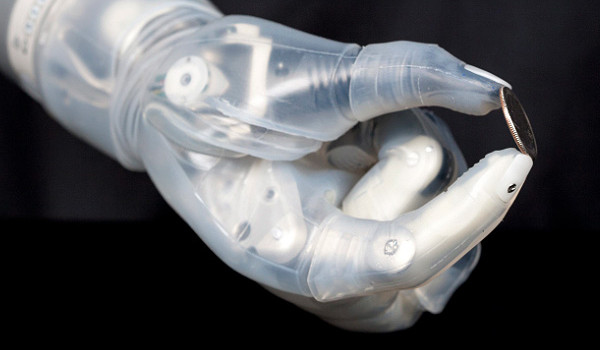An FDA news release has announced that the agency has given de novo approval to the Deka Arm System, the first prosthetic arm that can perform multiple, simultaneous powered movements controlled by electrical signals from electromyogram (EMG) electrodes.
The Deka Arm System is about the same size and weight as an adult arm. Its EMG electrodes detect electrical activity caused by the contraction of muscles close to where the prosthesis is attached. The electrodes send electrical signals to a computer processor in the prosthesis. That processor actuates a combination of mechanisms including switches, movement sensors, and force sensors that cause the impulses detected by the EMG electrodes to be translated into up to 10 specific powered movements.

The Deka Arm System (Courtesy Department of Veterans Affairs)
“This innovative prosthesis provides a new option for people with certain kinds of arm amputations,” said Christy Foreman, director of the Office of Device Evaluation at FDA’s Center for Devices and Radiological Health. “The Deka Arm System may allow some people to perform more complex tasks than they can with current prostheses in a way that more closely resembles the natural motion of the arm.”
Clinical information reviewed by FDA before its approval included a four-site Department of Veterans Affairs study in which 36 Deka Arm System study participants provided data on how the arm performed in common household and self-care tasks. According to the press release, “The study found that approximately 90 percent of study participants were able to perform activities with the Deka Arm System that they were not able to perform with their current prosthesis, such as using keys and locks, preparing food, feeding oneself, using zippers, and brushing and combing hair.”
The Deka Arm System was developed by Dean Kamen, best known as the inventor of the Segway electric scooter, described by CNNMoney as “one of the most famous flops (so far) of the 21st century.” Kamen also enlisted the help of prosthetists from Next Step Orthotics and Prosthetics and biodesigns, inc. on the project.
According to David Pope, writing for the Neurotech Business Report, Kamen started the project with $18.1 million from the Defense Advanced Resarch Projects Agency (DARPA) and, as a foundation to build on, the neuro-controlled Bionic Arm “pioneered at the Rehabilitation Institute of Chicago (RIC) by Todd Kuiken and a team of researchers.”
Pope reports that “Kuiken, director of RIC’s neural engineering center for artificial limbs, came up with the idea of re-attaching existing nerves in the amputee’s upper limb to bands of muscles in the chest, which serve as surrogate controllers for moving the artificial limb.” He explains that “(a)fter the replanted nerves have innervated the chest muscles, thinking about arm and hand movements causes these muscles to contract. A myoelectric sensor detects the contractions and sends the signals to an amplifier and digital signal processor, which in turn sends command signals to the artificial arm and hand.”
Refresh your medical device industry knowledge at MD&M East, June 9–12, 2014 in New York City.
According to FDA, the Deka Arm System can be configured for people with limb loss occurring at the shoulder joint, mid-upper arm, or mid-lower arm. It cannot be configured for limb loss at the elbow or wrist joint.
The Entovis pacemaker series includes Biotronik's home monitoring technology, which provides daily monitoring of the patient’s device. Biotronik says that it is the most advanced physiological therapy available via Closed Loop Stimulation (CLS).
Stephen Levy is a contributor to Qmed and MPMN.





